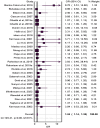The association between children's exposure to pesticides and asthma, wheezing, and lower respiratory tract infections. A systematic review and meta-analysis
- PMID: 38868160
- PMCID: PMC11167956
- DOI: 10.3389/fpubh.2024.1402908
The association between children's exposure to pesticides and asthma, wheezing, and lower respiratory tract infections. A systematic review and meta-analysis
Abstract
Background: Exposure to pesticides is a global public health problem, especially for children. Its association with chronic respiratory disease among children has attracted considerable attention, but the existing evidence remains inconclusive and cannot be certain. Therefore, this systematic review and meta-analysis aim to determine the global pooled effect size of association with pesticide exposure and asthma, wheezing, and respiratory tract infections among children.
Methods: A comprehensive search was conducted for relevant literature from electronic databases, including PubMed, Google Scholar, Hinari, Semantic Scholar, and Science Direct. Studies that provided effect size on the association between pesticide exposure and childhood asthma, wheezing, and respiratory tract infections in children were included. The articles were screened, data was extracted, and the quality of each study was assessed with four independent reviewers. Random effects models for significant heterogeneity and fixed effect models for homogeneous studies were conducted to estimate pooled effect sizes with 95% confidence intervals using Comprehensive Meta-Analysis version 3.3.070 and MetaXL version 2. Funnel plot and Higgins I 2 statistics were used to determine the heterogeneity of the included studies. Subgroup analyses were computed based on the types of pesticide exposure, study design, sample size category, and outcome assessment technique.
Result: A total of 38 articles with 118,303 children less than 18 years of age were included in this meta-analysis. Pesticide exposure among children increased the risk of asthma by 24%; (OR = 1.24, 95% CI: 1.14-1.35) with extreme heterogeneity (I 2 = 81%, p < 0.001). Exposure to pesticides increased the odds of developing wheezing among children by 34% (OR = 1.34, 95% CI: 1.14-1.57), with high heterogeneity (I 2 = 79%, p < 0.001) and also increased the risk of developing lower respiratory tract infection by 79% (OR = 1.79, 95% CI: 1.45-2.21) with nonsignificant low heterogeneity (I 2 = 30%, p-value = 0.18).
Conclusion: This meta-analysis provided valuable evidence supporting the association between childhood asthma, wheezing, and lower respiratory tract infection with pesticide exposure. The findings would contribute to a better understanding of the estimate of the effect of pesticide exposure on respiratory health in children and inform evidence-based preventive strategies and public health interventions.
Keywords: asthma; children; chronic respiratory diseases; meta-analysis; pesticide exposure; respiratory tract infection; systematic review.
Copyright © 2024 Keleb, Daba, Asmare, Bayou, Arefaynie, Mohammed, Tareke, Kebede, Tsega, Endawkie, Kebede, Abera, Abeje and Enyew.
Conflict of interest statement
The authors declare that the research was conducted in the absence of any commercial or financial relationships that could be construed as a potential conflict of interest.
Figures





Similar articles
-
The odds of developing asthma and wheeze among children and adolescents exposed to particulate matter: asystematic review and meta-analysis.BMC Public Health. 2025 Mar 31;25(1):1225. doi: 10.1186/s12889-025-22382-3. BMC Public Health. 2025. PMID: 40165124 Free PMC article.
-
Respiratory viral infection in early life and development of asthma in childhood: A protocol for systematic review and meta-analysis.Medicine (Baltimore). 2019 May;98(18):e15419. doi: 10.1097/MD.0000000000015419. Medicine (Baltimore). 2019. PMID: 31045799 Free PMC article.
-
Systematic Review: Association of Pesticide Exposure and Child Wheeze and Asthma.Curr Pediatr Rev. 2023;19(2):169-178. doi: 10.2174/1573396318666220510124457. Curr Pediatr Rev. 2023. PMID: 35538815
-
Environmental exposure to pesticides and respiratory health.Eur Respir Rev. 2015 Sep;24(137):462-73. doi: 10.1183/16000617.00006114. Eur Respir Rev. 2015. PMID: 26324808 Free PMC article. Review.
-
Respiratory and Allergic Effects in Children Exposed to Pesticides-A Systematic Review.Int J Environ Res Public Health. 2020 Apr 16;17(8):2740. doi: 10.3390/ijerph17082740. Int J Environ Res Public Health. 2020. PMID: 32316194 Free PMC article.
Cited by
-
Exposure to agricultural pesticides and wheezing among 5-12-year-old children in the Imperial Valley, CA, USA.Environ Epidemiol. 2024 Aug 19;8(5):e325. doi: 10.1097/EE9.0000000000000325. eCollection 2024 Oct. Environ Epidemiol. 2024. PMID: 39165346 Free PMC article.
References
-
- Akashe MM, Pawade UV, Nikam AV. Classification of pesticides: a review. Int J Res Ayurveda and Pharmacy. (2018) 9:144–50. doi: 10.7897/2277-4343.094131 - DOI

